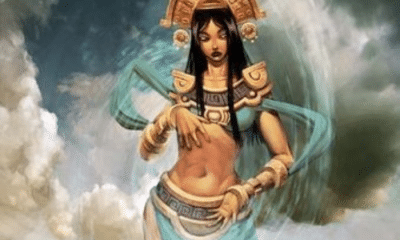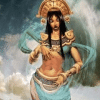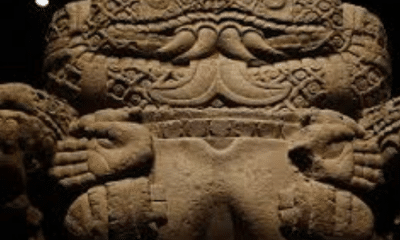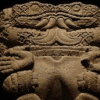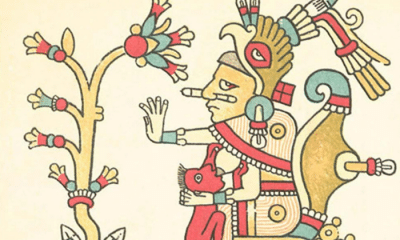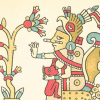Aztec
Mixcoatl: The Aztec God of the Night Sky
Mixcoatl was the god of hunting, the Milky Way, and the stars, but how important was he in the mythology of the Aztec people?
In ancient Mexican mythology Mixcoatl, sometimes called Camaxtli, held an important role.
He fathered the stars, created the Milky Way, and was even sometimes credited with teaching humans to make fire. He was also the god of the hunt and the patron of many regions in Mexico.
The fact that the Aztec Empire was composed of many different regions and groups, however, meant that Mixcoatl was not universally recognized as one of the most important gods of the pantheon.
Among the different people of pre-Colombian Mexico, Mixcoatl’s mythology and importance varied greatly. While the Olmec, for example, considered them their patron, the Mexicas believed he was a much more minor god.
The different beliefs regarding Mixcoatl and how he related to the other important gods of the pantheon illustrates how varied the many related cultures of the Aztec world actually were.
Mixcoatl and the Origin of the Heavens
In Aztec mythology, Mixcoatl was the god of the hunt.
In art, he was most often shown as a man with a black mask over his face and distinctive red and white stripes across his body. He carried Amhimitl, the dart he used in his role as a hunter.
While he was said to be a great hunter, however, the legends of Mixcoatl most closely associate him with the sky.
Mixcoatl was closely associated with Tezcatlipoca, the kingly god of war and magic. In some interpretations of the mythology, Mixcoatl was an aspect of Tezcatlipoca, while in others the warrior god sometimes took Mixcoatl’s form.
In one such story, Tezcatlipoca, in the form of Mixcoatl, was responsible for giving fire to humans. He spun the heavens around their axes, inventing the fire drill. He may have also been the first to create fire by striking flint.
When the heavens were spun to create fire, it created a whirling shape that lasted for the rest of time. Mixcoatl became the god of the Milky Way because he, or Tezcatlipoca in his shape, was responsible for its distinctive swirls.
Mixcoatl was also the father of two groups of sons, each numbering four hundred.
His first group of sons was known as the Centzon Huitznahua. The brothers were led by a single sister named Coyolxauhqui.
When they learned that their mother, Coatlicue, had become pregnant by sweeping a ball of feathers they plotted to kill her for dishonoring the family. When they attacked, however, she gave first to Huitzilopochtli, the sun god, who killed them all to protect his mother.
The Centzon Huitznahua became the four hundred stars of the southern sky. Mixcoatl’s other sons would become the northern stars.
The Centzonmimixcoa, as this second group was known, were killed as well. While the circumstances are unclear, surviving writings say that the gods of the northern stars were killed by Mixcoatl, his three brothers, and their sister Cuetchlachcihuatl.
Some stories claimed that Mixcoatl had another son, Quetzalcoatl. The feathered serpent was one of the principal gods of the Aztec pantheon who was believed to have created mankind.
There are several myths regarding the birth of Quetzalcoatl, including stories that he was another son of Coatlicue or that another goddess was impregnated when Mixcoatl shot an arrow into her stomach.
Mixcoatl was honored in ancient Mexico with a festival of feasting and hunting outside of the cities. Hunters dressed like him for the day and, along with the hunted game, a man and a woman were sacrificed in the god’s honor.
My Modern Interpretation
The many myths surrounding Mixcoatl painting him as the father of the stars, the creator of the Milky Way, and the patron of hunters. He was also linked to some of the Aztec Empire’s most important gods, Quetzalcoatl, Tezcatlipoca, and Huitzilopochtli.
The varied stories surrounding Mixcoatl, however, show the wide variety of traditions in Aztec mythology.
While Aztec culture is usually described in broad terms, ancient Mexico was actually an Empire of distinct and varied cultures. The three city-states that formed the empire’s primary coalition, Tenochtitlan, Texcoco, and Tlacopan, were each the center of their own regional culture.
They also exerted influence over many other groups that lived in the region of Central Mexico. Dozens of indigenous cultures were included in the Aztec Empire as it existed when the first Spaniards arrived.
These cultures were closely related to one another and had been in constant proximity for centuries. Their mythologies, languages, and rituals were thus very similar but regional variations were still common.
Mixcoatl was one deity who illustrated the variations between the cultures of the Aztec world. His importance and the details of his myths varied from group to group, making his overall role in Mexican mythology hard to pinpoint.
In the state of Tlaxcala, for example, he was worshipped as the central deity of the pantheon under the name Camaxtli. In other regions he was far less important, even being seen as a minor aspect of the more powerful Tezcatlipoca.
Much of what is today recognized as Aztec culture comes from the city of Tenochtitlan. There, Quetzalcoatl and Huitzilopochtli were the principal deities but Mixcoatl was less closely associated with them and far less important.
In some parts of Mexico, the god Tlahuizcalpantecuhtli was associated with Quetzalcoatl, Tezcatlipoca, and Huitzilopochtli more than Mixcoatl. In Toltec mythology, the other gods sacrificed themselves in honor of Tlahuizcalpantecuhtli after he died in an attempt to make the sun move across the sky.
Tlahuizcalpantecuhtli was revered by the Toltec as the god of the morning star and represented the day. In this, he was the opposite of Mixcoatl.
Despite being opposites, the two were depicted in almost the same way. They shared the same mask, stripes, coloration, and even weapon in their art.
This suggests that Tlahuizcalpantecuhtli and Mixcoatl were different variations of a sky god archetype. In some areas the god of the night sky who created the stars was held in high esteem, while other regions revered the god or morning who made the sun move.
In Summary
In Aztec mythology, Mixcoatl was a god of hunting. He was also associated closely with the night sky.
According to some myths he, or another god in his guise, created the Milky Way by using the heavens as a fire drill. He was also the father of 800 sons who became the stars of the night sky after their deaths.
In his myths, Mixcoatl was closely associated with some of the most important Aztec gods, including Quetzalcoatl and Tezcatlipoca. Surviving sources, however, have no consensus over what his relationship was with these other gods.
There were also differences in how important Mixcoatl actually was. While some people believed him to be a relatively unimportant god, or even an aspect of a more influential deity, some cities believed him to be their patron and one of the primary gods of the pantheon.
The varied beliefs surrounding Mixcoatl illustrate clearly that the Aztec Empire was not a single unified culture. Instead, it was a confederacy of many different states and tribes whose cultures were closely related but distinct from one another in their beliefs and practices.


